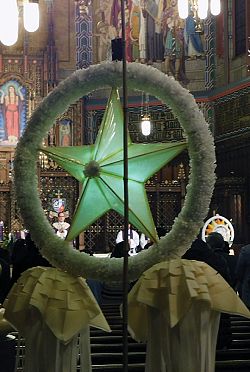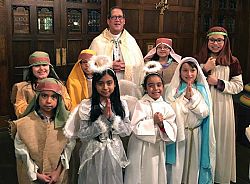Simbang Gabi and las posadas festivities offer cultural Christmas celebrations to the diocese

SALT LAKE CITY — As Christmas arrived on the horizon the cultural celebrations of the Simbang Gabi and Las Posadas, which anticipate the coming of Jesus, were at full speed in the Catholic Diocese of Salt Lake City.
On Dec. 15 the Cathedral of the Madeleine opened its doors to the Filipino tradition known as the Simbang Gabi.
Simbang Gabi, literally translated as ‘Night Mass,’ is a 400-year-old Christmas tradition of the Philippines, where the festive season starts as early as September and lasts until the feast of the Three Kings in January. The Simbang Gabi is the name for the novena of Masses from Dec. 15 to Dec. 23 to usher in the birth of Christ. The celebration is called the Misa de Gallo (Mass of the Rooster) by the Tagalog-speaking people who live on the island of Luzon and in other parts of the country because the tradition is to celebrate the Mass before dawn.
The celebration started with a procession of parols into the cathedral. This festive Christmas decoration is part of the Filipino Christmas tradition. Each parol is made by men and women and even children of the Misan Bayan, which is the name of Filipino community in Utah.
The parol is a star-shaped ornamental lantern traditionally made of bamboo and paper, with its shape evoking the Star of Bethlehem.
After the parols’ procession, Bishop Oscar A. Solis greeted and welcomed everyone to the celebration.
“Welcome all to the celebration of the Holy Mass of the Filipino tradition called Simbang Gabi. … Every-body is so excited for bringing this tradition here to the cathedral in the Diocese of Salt Lake City,” Bishop Solis said.
The Mass was concelebrated by Fr. Jason Marco and Fr. Jesryll Intes from the Diocese of Cheyenne, Wyo.; Fr. Max B.T. Omaña, chaplain of the Christ Prince of Peace Catholic Community at Hill Air Force Base; Fr. Joseph Frez, parochial vicar of Saint Therese of the Child Jesus Catholic Parish; Fr. Jose A. Barrera Hernandez, administrator of Saint Therese of the Child Jesus Parish; and Fr. Martin Diaz, rector of the Cathedral of the Madeleine.
Bishop Solis in his homily explained the celebration in more detail, as well as the importance of preparing for the coming of the Lord.
Grace Wong, a parishioner of Saint Joseph the Worker who was dressed in a black traditional costume for the Mass, said she was very happy to be able to be there that night.
“Since when I was young this is a tradition that our family follows. We always try to complete the nine Masses, which is the novena,” said Wong, adding that she was thrilled that Bishop Solis presided at this year’s celebration.
“It means a lot. We really feel blessed to have him in Utah leading our Catholic faith. … Since he is Filipino, we can make a lot more activities and experience them much deeper and pass them on better to our children,” she said.
This year the diocesan Simbang Gabi was celebrated with the theme ‘Jesus: Clear Light” (Heisis: Maningning na Liwanag).
“We have this theme to emphasize our hope that our community, especially the youth, will walk towards the clear light of Jesus inspired by the life of a recently beatified person, Chiara Badano,” according to the program for the festivities.
Bandano, who was Italian, was diagnosed with bone cancer at the age of 16 and died two years later. She offered her suffering to Jesus and tried to offer comfort to other patients in the hospital where she was admitted.
After the Mass everyone was invited to an informal reception with traditional Filipino dishes.
On Dec. 16, the night after the Simbang Gabi novena started, dozens of people gathered at the cathedral to celebrate the beginning of the diocesan posadas.
Posadas are a traditional Hispanic religious celebration. Each night between Dec. 16 and Dec. 24 they commemorate the journey that Joseph and Mary made from Nazareth to Bethlehem. Along the way they sought a safe refuge where Mary could give birth to the baby Jesus. When they were unable to find lodging in Bethlehem, Joseph and Mary were forced to seek shelter in a stable, where the Christ Child was born.
During the posadas at the cathedral , children dressed as pastors, pilgrims, Mary and Joseph reenacted the journey.
“This time of the year always brings a lot of joy and excitement to all my family,” said Maria Jimenez, whose family attended the posada at the Cathedral of the Madeleine, where they are parishioners.
“It’s a tradition that we usually celebrate. … We want to keep the tradition alive and it also makes you remember where you are from, and your traditions and customs,” she added.
The posada started with the singing of the traditional song, with its lyrics, “posada te piden estos peregrinos, que vienen cansados ...” (“Inn, we ask you as pilgrims, we have come very tired.”)
The diocesan Hispanic Commission and Office of Hispanic Ministry plan the posadas annually, asking for the participation of the parishes and missions so that each night during the novena, a different diocesan parish or mission participates.
© Copyright 2024 The Diocese of Salt Lake City. All rights reserved.


Stay Connected With Us